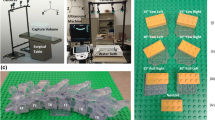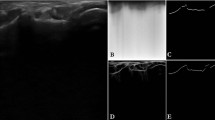Abstract
Three-dimensional (3D) measurement of the spine can provide important information for functional, developmental, diagnostic, and treatment-effect evaluations. However, existing measurement techniques are either 2-dimensional, highly invasive, or involve a high radiation dose, prohibiting their widespread and repeated use in both research and clinical settings. Non-invasive, non-ionizing, 3D measurement of the spine is still beyond the current state-of-the-art. Towards this goal, we developed an intensity-based hierarchical CT-ultrasound registration approach to quantify the 3D positions and orientations of lumbar vertebrae from 3D freehand ultrasound and one-time computed tomography. The method was validated using a human dry bone specimen (T12-L5) and a porcine cadaver (L2-L6) by comparing the registration results with a gold standard fiducial-based registration. Mean (SD) target registration error and percentage of successful registration were 1.2 (0.6) mm and 100% for the human dry bone specimen, and 2.18 (0.82) mm and 92% for the porcine cadaver, indicating that the method is accurate and robust under clinically realistic conditions. Given that the use of ultrasound eliminates ionizing radiation during pose measurements, we believe that the hierarchical CT-ultrasound registration method is an attractive option for quantifying 3D poses of individual vertebra and motion segment, and thus warrants further investigations.












Similar content being viewed by others
References
Aurouer, N., I. Obeid, O. Gille, V. Pointillart, and J. M. Vital. Computerized preoperative planning for correction of sagittal deformity of the spine. Surg. Radiol. Anat. 31:781–792, 2009.
Brendel, B., S. Winter, A. Rick, M. Stockheim, and H. Ermert. Registration of 3D CT and ultrasound datasets of the spine using bone structures. Comput. Aided Surg. 7:146–155, 2002.
Cobb, J. R. Outline for the study of scoliosis. Instr. Course Lect. 5:261–275, 1948.
Dath, R., A. D. Ebinesan, K. M. Porter, and A. W. Miles. Anatomical measurements of porcine lumbar vertebrae. Clin. Biomech. (Bristol., Avon.) 22:607–613, 2007.
Dickey, J. P., M. R. Pierrynowski, D. A. Bednar, and S. X. Yang. Relationship between pain and vertebral motion in chronic low-back pain subjects. Clin. Biomech. (Bristol., Avon.) 17:345–352, 2002.
Doyle, W. Operation useful for similarity-invariant pattern recognition. J. ACM. 9:259–267, 1962.
Fujiwara, A., K. Tamai, H. S. An, T. Kurihashi, T. H. Lim, H. Yoshida, and K. Saotome. The relationship between disc degeneration, facet joint osteoarthritis, and stability of the degenerative lumbar spine. J. Spinal Disord. 13:444–450, 2000.
Gill, S., P. Abolmaesumi, G. Fichtinger, J. Boisvert, D. Pichora, D. Borshneck, and P. Mousavi. Biomechanically constrained groupwise ultrasound to CT registration of the lumbar spine. Med. Image Anal. 16:662–674, 2012.
Grood, E. S., and W. J. Suntay. A joint coordinate system for the clinical description of three-dimensional motions: application to the knee. J Biomech. Eng. 105:136–144, 1983.
Haberland, N., K. Ebmeier, J. P. Grunewald, R. Hliscs, and R. L. Kalff. Incorporation of intraoperative computerized tomography in a newly developed spinal navigation technique. Comput. Aided Surg. 5:18–27, 2000.
Haque, M. A., W. Anderst, S. Tashman, and G. E. Marai. Hierarchical model-based tracking of cervical vertebrae from dynamic biplane radiographs. Med. Eng. Phys. 35:994–1004, 2013.
Haughton, V. M., B. Rogers, M. E. Meyerand, and D. K. Resnick. Measuring the axial rotation of lumbar vertebrae in vivo with MR imaging. Am. J. Neuroradiol. 23:1110–1116, 2002.
Hayes, M. A., T. C. Howard, C. R. Gruel, and J. A. Kopta. Roentgenographic evaluation of lumbar spine flexion-extension in asymptomatic individuals. Spine (Phila Pa 1976) 14:327–331, 1989.
ISO 5725-2:1994. Accuracy (trueness and precision) of measurement methods and results. Part 2: Basic method for the determination of repeatability and reproducibility of a standard measurement method. 1994.
ISO 5725-4:1994. Accuracy (trueness and precision) of measurement methods and results. Part 4: Basic methods for the determination of the trueness of a standard measurement method. 1994.
Koo, T. K., J. Y. Guo, C. Ippolito, and J. C. Bedle. Assessment of scoliotic deformity using spinous processes: comparison of different analysis methods of an ultrasonographic system. J. Manip. Physiol. Ther. 37:667–677, 2014.
Landini, G. Auto threshold. http://fiji.sc/Auto_Threshold. 2015.
McDonald, C. P., C. C. Bachison, V. Chang, S. W. Bartol, and M. J. Bey. Three-dimensional dynamic in vivo motion of the cervical spine: assessment of measurement accuracy and preliminary findings. Spine J. 10:497–504, 2010.
Muratore, D. M., B. M. Dawant, and R. L. Galloway. Vertebral surface extraction from ultrasound images for technology-guided therapy. Proc. SPIE 3661:1499–1510, 1999.
Nelder, J. A., and R. Mead. A simplex method for function minimization. Comput. J. 7:308–313, 1965.
Ochia, R. S., N. Inoue, S. M. Renner, E. P. Lorenz, T. H. Lim, G. B. Andersson, and H. S. An. Three-dimensional in vivo measurement of lumbar spine segmental motion. Spine (Phila Pa 1976) 31:2073–2078, 2006.
Olsson, D. M., and L. S. Nelson. The Nelder-Mead simplex procedure for function minimization. Technometrics 17:45–51, 1975.
Pearcy, M., I. Portek, and J. Shepherd. Three-dimensional x-ray analysis of normal movement in the lumbar spine. Spine (Phila Pa 1976) 9:294–297, 1984.
Prewitt, J. M. S., and M. L. Mendelsohn. The analysis of cell images. Ann. N. Y. Acad. Sci. 128:1035–1053, 1966.
Rasoulian, A., P. Abolmaesumi, and P. Mousavi. Feature-based multibody rigid registration of CT and ultrasound images of lumbar spine. Med. Phys. 39:3154–3166, 2012.
Rasoulian, A., A. Seitel, J. Osborn, S. Sojoudi, S. Nouranian, V. A. Lessoway, R. N. Rohling, and P. Abolmaesumi. Ultrasound-guided spinal injections: a feasibility study of a guidance system. Int. J. Comput. Assist. Radiol. Surg. 10:1417–1425, 2015.
Ron, O., L. Joskowicz, C. Milgrom, and A. Simkin. Computer-based periaxial rotation measurement for aligning fractured femur fragments from CT: a feasibility study. Comput. Aided Surg. 7:332–341, 2002.
Shao, W., R. Wu, K. V. Ling, C. H. Thng, H. S. Ho, C. W. Cheng, and W. S. Ng. Evaluation on similarity measures of a surface-to-image registration technique for ultrasound images. Med. Image Comput. Comput. Assist. Interv. 9:742–749, 2006.
Singer, S., and J. Nelder. Nelder-Mead algorithm. Scholarpedia J. 4:2928, 2009.
Tsao, J., C. P. Chiodo, D. S. Williamson, M. G. Wilson, and R. Kikinis. Computer-assisted quantification of periaxial bone rotation from X-ray CT. J Comput. Assist. Tomogr. 22:615–620, 1998.
Weber, P. K., J. C. Schlegel, J. Meiche, L. Peter, and U. Harland. A system for ultrasound-based intraoperative navigation in spine-surgery. IEEE Int. Ultrasound Symp. 2:1361–1364, 2001.
Wever, D. J., A. G. Veldhuizen, J. P. Klein, P. J. Webb, G. Nijenbanning, J. C. Cool, and J. R. Horn. A biomechanical analysis of the vertebral and rib deformities in structural scoliosis. Eur. Spine J. 8:252–260, 1999.
Winter, S., B. Brendel, I. Pechlivanis, K. Schmieder, and C. Igel. Registration of CT and intraoperative 3-D ultrasound images of the spine using evolutionary and gradient-based methods. IEEE Trans. Evolut. Comput. 12:284–296, 2008.
Winter, S., I. Pechlivanis, C. Dekomien, C. Igel, and K. Schmieder. Toward registration of 3D ultrasound and CT images of the spine in clinical praxis: design and evaluation of a data acquisition protocol. Ultrasound Med. Biol. 35:1773–1782, 2009.
Yan, C. X., B. Goulet, J. Pelletier, S. J. Chen, D. Tampieri, and D. L. Collins. Towards accurate, robust and practical ultrasound-CT registration of vertebrae for image-guided spine surgery. Int. J. Comput. Assist. Radiol. Surg. 6:523–537, 2011.
Yan, C. X., B. Goulet, D. Tampieri, and D. L. Collins. Ultrasound-CT registration of vertebrae without reconstruction. Int. J. Comput. Assist. Radiol. Surg. 7:901–909, 2012.
Acknowledgments
The authors would like to thank Dr. Jingyi Gao for her initial contribution of this work, Christopher Kirby, Weiling Zhang, Komal Khattak, and Nicholas Darcangelo for their assistance in data collection and analysis, Dr. Tom Foster, Erik Saluste, Angela Holland and Sandy Smashe for their involvements in arranging and performing the CT scans at Strong Memorial Hospital, and Anne Smith for her help on proofreading the manuscript. This work was supported by an intramural fund of New York Chiropractic College.
Author information
Authors and Affiliations
Corresponding author
Additional information
Associate Editor Karol Miller oversaw the review of this article.
Electronic supplementary material
Below is the link to the electronic supplementary material.


Rights and permissions
About this article
Cite this article
Koo, T.K., Kwok, W.E. Hierarchical CT to Ultrasound Registration of the Lumbar Spine: A Comparison with Other Registration Methods. Ann Biomed Eng 44, 2887–2900 (2016). https://doi.org/10.1007/s10439-016-1599-1
Received:
Accepted:
Published:
Issue Date:
DOI: https://doi.org/10.1007/s10439-016-1599-1




